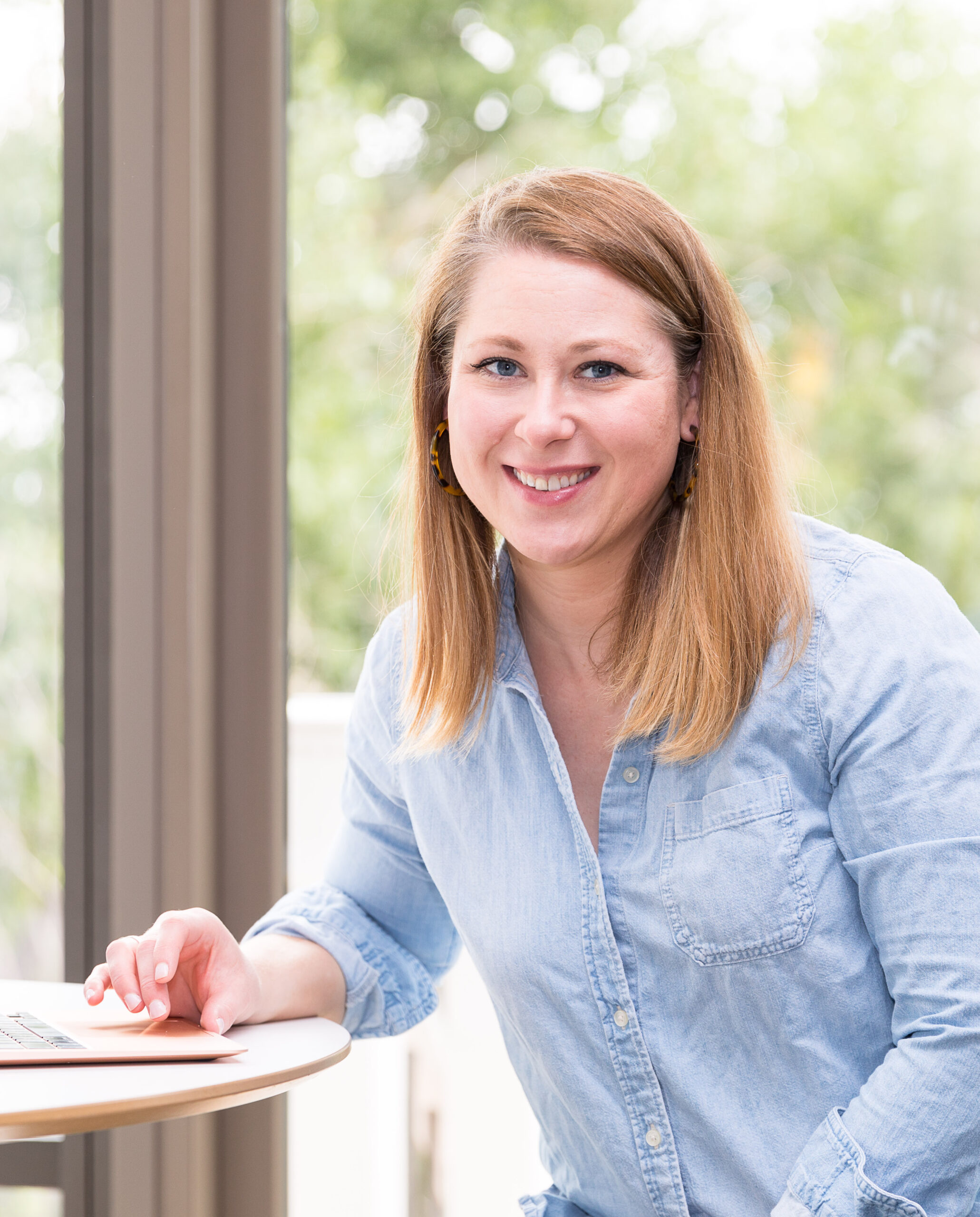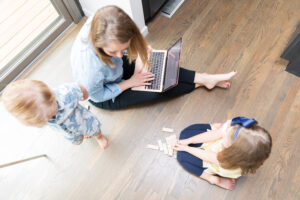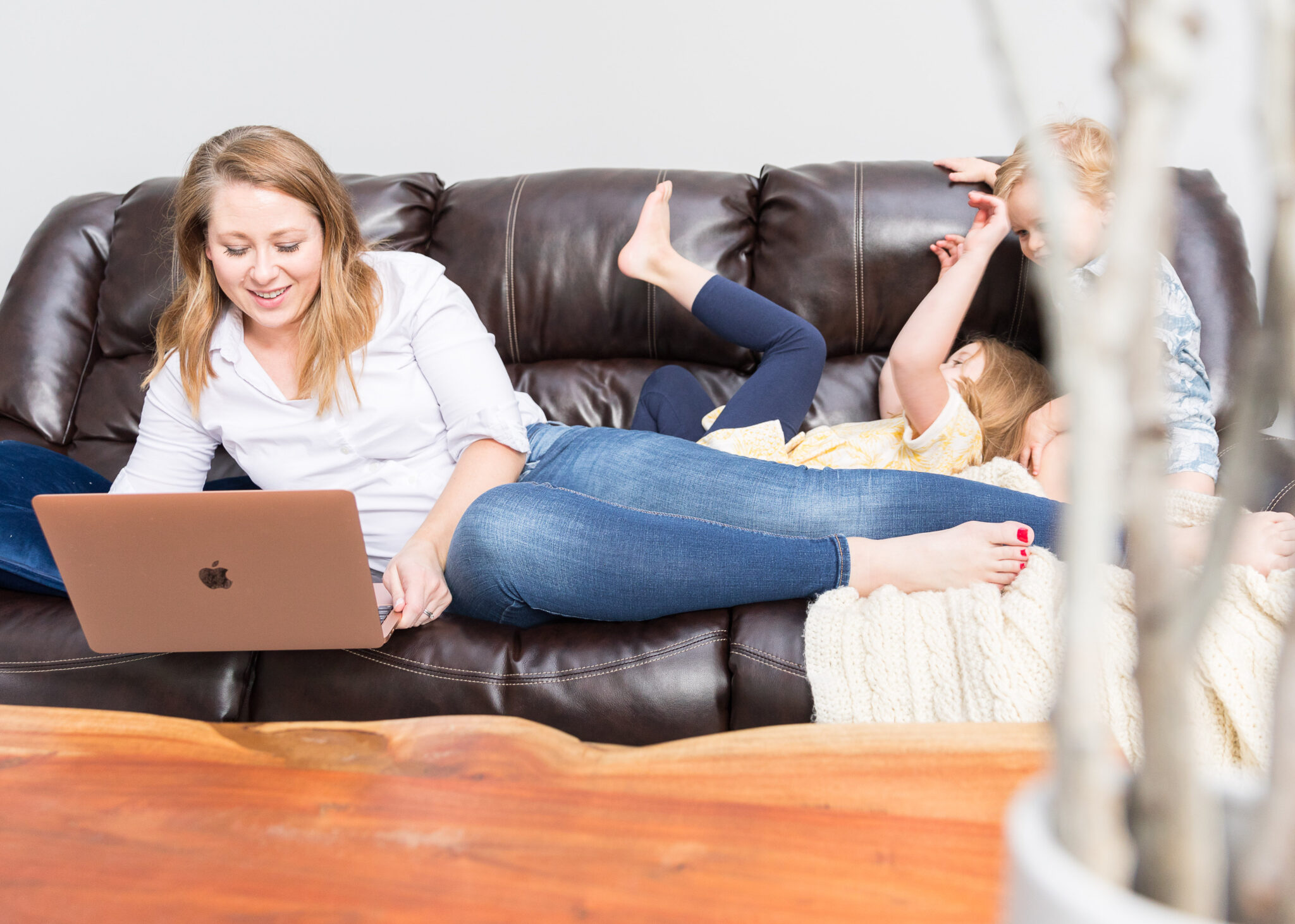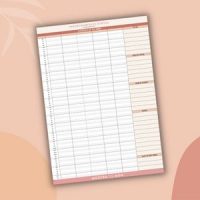
Are you looking for easy ways to implement independent play time by age with your kids? Start here to learn how to start from scratch, encourage independent play in kids that need entertainment, teach independent play with babies and toddlers, prepare preschoolers for independent play at school, and everything you need to have quiet time in your home.
Why is independent playtime important?
I am a firm believer that independent play is important and vital for YOU. You need to be able to leave your kids and know that they will be fine by themselves.
But independent play time by age is also important for your child. Your child needs to be able to tap into their creativity, find amusement in a plain room, get them out of a bored rut, and just enjoy being alone.
Not sure how this works? Keep reading!
- Why is independent playtime important?
- Independent Play Encourages Imagination
- Independent Play Creates Daily Routine, Discipline, & Safe Space Security
- Let’s talk about toy rotation (with a free chart!)
- Independent Play Time by Age Teaches Kids To Entertain Themselves
- Appropriate Independent Play Time by Age for young children
- What Age To Start Independent Play
- How To Start Doing Independent Play Time By Age If Your Kids Are Resistant
- Independent Play Time by Age
- FAQ:
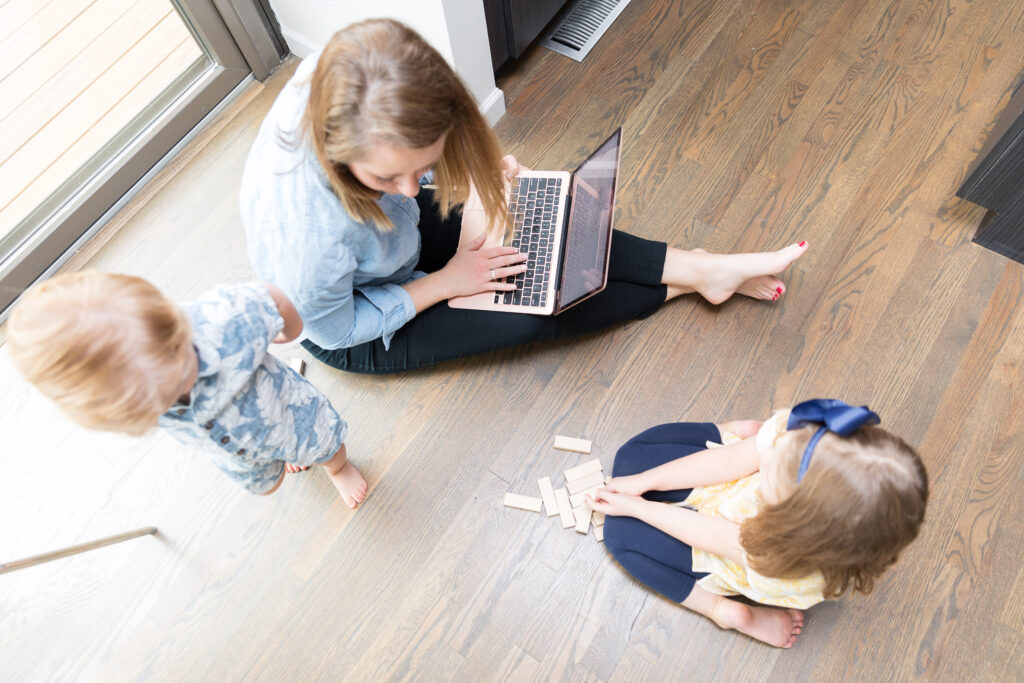
Independent Play Encourages Imagination
One of the downfalls of the “Screen Age” is that kids everywhere rely on screens to entertain them. Videos, photos, random commercials…they prefer any screen over a box of crayons, or a puzzle.
Don’t get me wrong! We are PRO-SCREENS in my house. But, we are also PRO-CREATIVITY. And sometimes as a mother, that takes work to establish.
Kids don’t naturally prefer books. Or a doll baby. They will always choose the movie over a puzzle. (It’s like a mom that says, “my kids only want cake for dinner!” And I say, “OF COURSE. What human being is going to choose broccoli over cake?”)
But, that doesn’t mean that broccoli isn’t really good for them. Or quiet. Or peace for them to have their own thoughts. All of these things are important…they just take work to establish.
Both of my kids (ages 2, 4) play independently really well. And the result of these periods of play, is that they create stories, and plays, and “movie puppet shows”, and anything else that comes out of their heads.
I love this so much, and I never want these creative streaks to end!
Independent Play Creates Daily Routine, Discipline, & Safe Space Security
Sometimes I try to view the day from kids’ perspectives.
I want their days to be consistent and predictable enough, so they know that after lunch they have naptime and quiet time. (Read my complete naptime guide here to see how to make it work for you!)
I want them to not be surprised when I ask them to play by themselves for 30 minutes.
The key is that kids are always looking for the “fun thing”. They are just waiting for me to pull out the candy or new Disney movie. If there is a chance that at 1 pm I will pull out candy, then OF COURSE they won’t want to play by themselves.
But, if everyday there is no chance of candy at 1 pm, then the option of independent play time by age is a really normal good one for them. They will go along with it. That routine creates discipline…which then because normal for your child.
I also think independent play encourages security.
My kids don’t have a playroom. Instead, their bedrooms are full of their toys, books, legos, blocks, and piles and piles of random things they can pull out. Those are THEIR THINGS. They have free rein.
That personal space gives them possession of their things…which gives them security. They feel safe during play time, because it’s their space. This means a lot to young kids.
Now, you don’t need huge bedrooms or piles of toys to accomplish this. I’ve been to Africa where a child might only have one deflated ball that is theirs. That ball is their security. And asking them to independently play with their ball is a safe place for them. Of course they are ok playing with their ball! That is what I want my kids to feel.
I read somewhere that kids like reading the same book over and over again because it’s predictable and they can count on it to be the same every time.
I think it’s the same way with toys! I think it’s healthy for kids to have limited toys, and to experience the same puzzles over and over again. There is a security in those puzzles that a new toy can’t accomplish.
Let’s talk about toy rotation (with a free chart!)
If you bring up “toy rotation” in a moms club, you will have every mom in the world talking about cubbies, and cabinets, and charts, and rotation schedules.
Y’all, that COMPLETELY overwhelms me.
Yes, of course you can have a complicated schedule that lets you rotate toys over and over again to give kids new things to play.
But, if you are looking for an easy way to accomplish this same thing without changing your home organization…you need my easy toy rotation solution.
The idea behind this chart is simple. Just choose every week which 3-5 toys your kids will play with. And that’s it.
I like categorizing toys in my head. (Only my head! No need to write this down!) My categories might be:
- Building toys (blocks, Legos, Duplos, Lincoln Logs, Magnatiles)
- Cars and trains (train sets, matchbox cars, pull toys)
- Animals/ People (baby animals, Little People sets)
- Craft cabinet (coloring, stickers, Water Wow, paint)
- Other (puzzles, books, card games, etc.)
Every week just pick one from each category that are your toys for that week. You might tell your kids:
“This week we are playing with matchbox cars, your lego set, coloring, and baby animals….THAT’S IT!”
Try it! Sign up to get my free block schedule template that has a toy rotation solution built in!

Independent Play Time by Age Teaches Kids To Entertain Themselves
We have recently changed up our childcare routine, and my kids have had a LOT more stimulus and interaction from babysitters and preschool. This is really good for them – don’t get me wrong. But I think they have also kind of forgotten how to play by themselves.
When they were younger, they were used to 60 minute periods of quiet and play time. But now, we have lost a lot of that schedule.
So….I am teaching them all over again. Right now we get home from preschool/toddler playschool around 1 pm, and my instinct is to immediately jump into nap time. My son usually gets tired around this time, and heaven knows that I’m needing to get back to work.
But, I figured out that this is the perfect time to give them more independent play time time by age. Some days I put them in their room to “decompress” by themselves. But some days I want them to have “brother sister time” and they are so excited to play together after time apart.
This 30-45 minute block has because the most creative part of their day. They entertain themselves. Create stories. Get out alllll the blocks and cars, and genuinely love that time to reconnect and calm down.
If you feel like your kids are constantly wired and over-stimulated, make sure you intentionally plan a time of the day for them to be by themselves. Kids won’t ask for this to happen – but they will thank you!
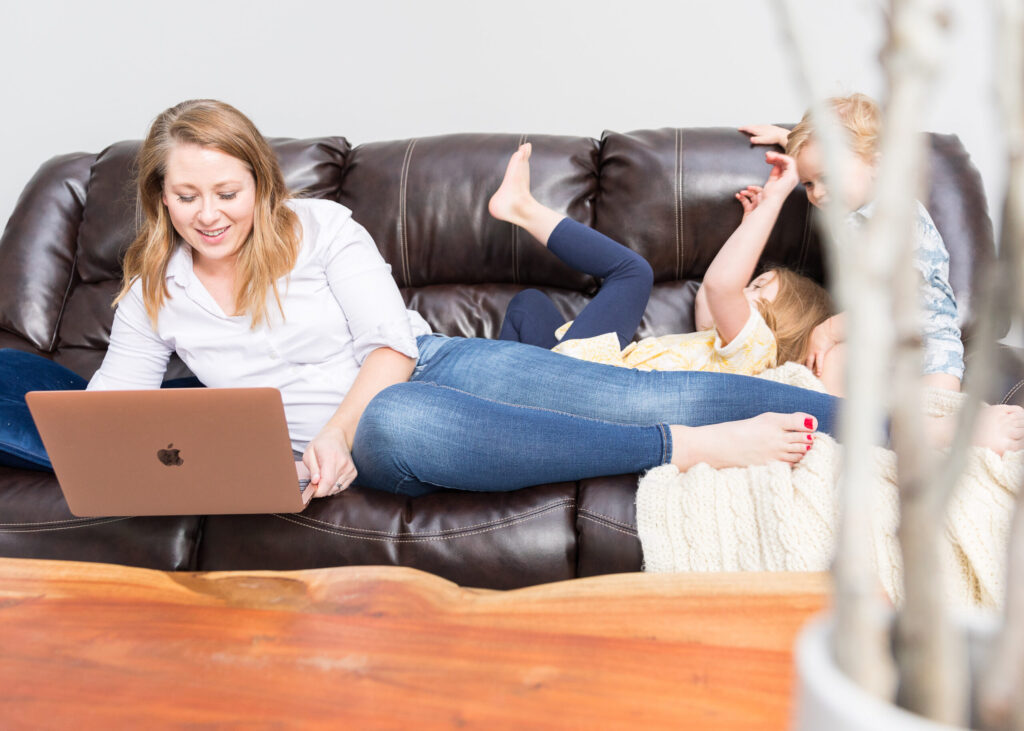
Appropriate Independent Play Time by Age for young children
I think the amount of time is totally up to the parent. You know your kids best. So anything I say here PLEASE adjust to your family (or disregard all together!)
But, I also believe that every age can learn independent play. Like this amazing article says “Stop the mom guilt! It’s ok for your child to play alone!”
I start teaching my kids to play by themselves with then are 6 months old. YEP – SIX MONTHS OLD. What to know how this works? Keep reading!
Use this independent play time by age guide to help you decide what’s best for your child!
What Age To Start Independent Play
I like to start nurturing independent play when my babies are 6 months old. This is when they aren’t even sitting up yet – but they are able to lay on their tummies for a few minutes at a time.
I put them in their room (very near me) on their tummies with some toys in reach. I usually leave them for 5-10 minutes, or until they get cranky. If you are a few feet away, definitely use a baby monitor!
I do this once a day or so, just to teach them that I don’t need to be available all the time. This shows your baby that they can be by themselves and it’s ok. Try it!
Infant – 8 To 10 Months: Recognize Simple Cause And Effect
Once your babies are able to sit up and squirm around, try putting some toys a little out of reach! They learn quickly how to reach, roll over, and squirm to get what they want. At this point, I still leave my babies for about 10-20 minutes, depending on what they can handle.
Baby toys that involve their feet (like this simple piano toy that I LOVE!) are perfect for this because you can even leave your baby in their crib for 20 minutes, and they learn how to move their feet to create cause and effect.
TO BE CLEAR. Your baby doesn’t need to be by themselves for this to work! If you are working at a desk, set up a play area, playpen, or pack n’ play at your feet (with a baby fence if need be) to let them play near you. This is still independent play time by age – and often works for longer than 10-20 minutes.
See here how I set up a cheap play area near my desk that works great for babies and toddlers.
1 To 3 Years: Manipulate The Environment
For your younger kids, independent play is all about trickery.
Yep trickery.
You want your younger kids to THINK they will have more fun by themselves in their play area. This can happen with a new rotation of toys, new music, new ideas…anything that gives them excitement when they play.
When my kids turn 1 years old, they are playing by themselves about an hour everyday. Sometimes it’s more. Sometimes it’s less – but they are capable of 1 hour.
This is the time to pull out big (but independent) toys – Lincoln Logs, trains, big blocks, imaginative play…anything to keep their attention for a long period of time.
When my kids turn 2 years old, they can play by themselves for 2 hours. I usually check on them a few times, help with changing toys or getting out some new crafts.
But, this is the time to make their surroundings appear SO FUN that they don’t want to miss out.
TIP: If you keep your toys in a playroom, but ask them to play by themselves in a bedroom with very little toys, then you might not have much success. Definitely make sure they are NEAR the possibility of new fun toys, and they will be much more likely to cooperate!
3 To 4 Years: Alternate Toy Play With Nurturing
When my daughter turned 3, so wanted to do “big kid” things. Legos. Painting. Play-dough.
And, as every mom knows, those are NOT mom-free activities! I needed to be involved. But, that’s ok! I work from home, and am able to oversee larger activities.
It was during this time that I re-vamped my craft cabinet resources so she could access it by herself. SHE is able to open the cabinet, find what she wants to play with, and have a system for doing crafts herself.
4 To 5 Years: Pretend Play
Independent play time by age adjusts with every season. Once my daughter turned 4 and 5, she took a lot of control of her playtime and began having new ideas for how she wanted to have quiet time.
Sometimes she moves her quiet time to the kitchen to play with an activity or her craft cabinet. Sometimes she moves into the loft to set up a fort and do more pretend play.
The rules stay the same. Quiet time. Don’t talk to mom. Play whatever you want.
I also set up a timer/clock at this point to tell her when she can move on to outside time or screen time. I’ve started saying “You can go do something else when there is a 3” – to teach her more about telling time.
5 To 6 Years: Cope With Feelings During Play
Now this is new territory for me. My daughter just turned 5, so I know we are moving into the stage where she has more of an emotional attachment to her play. She often wants to be with me and doesn’t understand why I need to be in meetings.
I try to explain how I have work hours and she has play hours. But when I’m done working, we have time together. I know this season will evolve and things will get harder.
This is also the season where kids learn to read, and I’m so excited to find new library books so she can explore reading during her quiet time.
6 To 7 Years: Trying New Ideas
First grade! This is the season for HOMEWORK and READING and LEARNING activities. I’m so excited to watch my daughter explore these new learning adventures. Now is also the time that younger siblings and older siblings can play together and you can trust them to have self-regulation. What a treat!
If you need new ideas to promote learning at home, let me introduce KiwiCo..
We have used KiwiCo for years for both our kids. It’s an excellent monthly learning subscription that makes our lives so much better.
Every month my kids get an age-appropriate activity box that has 3-4 craft/activities that uses the STEM process (science, technology, engineering, math) to give you smart, hands-on activities to do with your child. They have awesome boxes that are age-appropriate for all ages.
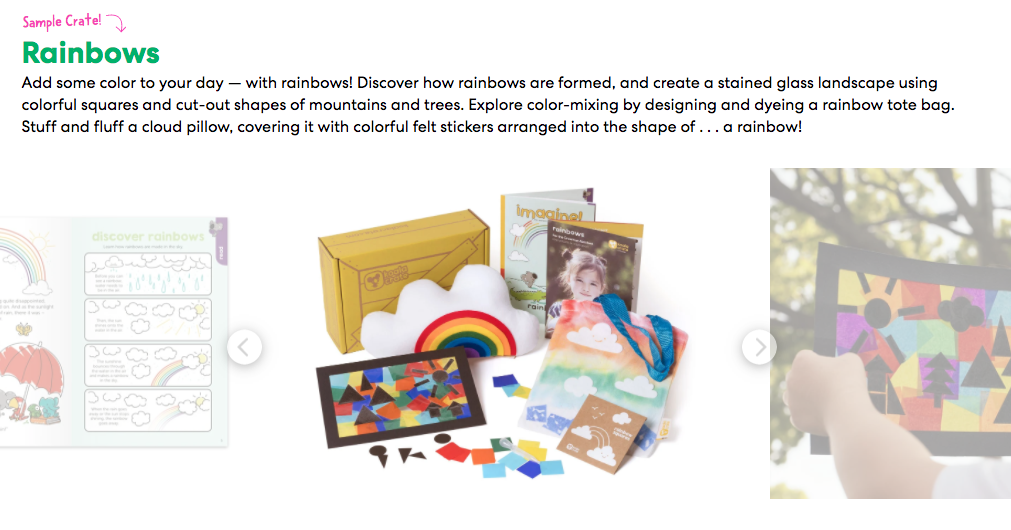
This is the PERFECT resource when you just need some help with your kids. You can even get just ONE BOX (no subscription necessary.)
I also love keeping all the previous boxes so I have a supply of activities I can rotate year-round. I keep all her old activities in an organized plastic box and pull out one or two a week. (“Do you want to do your doctor kit or dinosaur matching game this week?”)
To see how I store and re-use our KiwiCo activities, see my Insta Stories here.
To try out KiwiCo for one month with a 15% discount, click here and use the code LEARN!
Read my full KiwiCo and Kiwi Panda Crate review here. I share an unusual perspective!

How To Start Doing Independent Play Time By Age If Your Kids Are Resistant
THIS is the money question. How do you start independent play when your kids are resistant? The answer: START SMALL. Start with 10 minutes. Then 20 minutes. Then 30 minutes. Add new toys. Rotate toys that haven’t been played with in awhile. GO SLOW AND GROW WITH YOUR CHILD.
And…that’s it friend! Please share your quiet time and independent play time tips in the comments! I’m ALWAYS looking for new ways to improve our nap time solutions!
Independent Play Time by Age
9 GENIUS Tips for Working from home with a newborn
When do kids stop napping: 16 Foolproof Tips for Quiet Time and Naptime
Free 40 Hour Work From Home Mom Schedule Template
FAQ:
-
How long should a child play independently?
I like to start nurturing independent play when my babies are 6 months old. This is when they aren’t even sitting up yet – but they are able to lay on their tummies for a few minutes at a time.
I put them in their room (very near me) on their tummies with some toys in reach. I usually leave them for 5-10 minutes, or until they get cranky. If you are a few feet away, definitely use a baby monitor!
I do this once a day or so, just to teach them that I don’t need to be available all the time. This shows your baby that they can be by themselves and it’s ok. Try it!
-
How long should a three year old play independently?
When my kids turn 3 years old, they can play by themselves for 1- 2 hours. I usually check on them a few times, help with changing toys or getting out some new crafts.
-
What age does independent play start?
I like to start nurturing independent play when my babies are 6 months old. This is when they aren’t even sitting up yet – but they are able to lay on their tummies for a few minutes at a time.
-
How long should a 7 year old play alone?
When a child is 7 years old, they can play by themselves for 1- 2 hours. I usually check on them a few times, help with changing toys or getting out some new crafts.
-
Should my 4 year old play alone?
I am a firm believer that independent play is important and vital for YOU. You need to be able to leave your kids and know that they will be fine by themselves.
But independent play time by age is also important for your child. Your child needs to be able to tap into their creativity, find amusement in a plain room, get them out of a bored rut, and just enjoy being alone.

